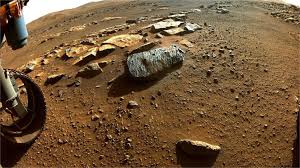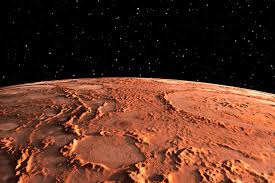Planet Mars, often referred to as the “Red Planet,” has long captured the imagination of scientists, astronomers, and the general public. Its reddish appearance, visible to the naked eye, and its position as Earth’s closest planetary neighbor make it a prime candidate for exploration and study. Recent advancements in technology and ongoing missions have expanded our understanding of Planet Mars, but many mysteries still remain.
The Unique Characteristics of Planet Mars

Planet Mars is the fourth planet from the Sun and is smaller than Earth, with a diameter of approximately 6,779 kilometers. It is characterized by its thin atmosphere, composed primarily of carbon dioxide, with traces of nitrogen and argon. Unlike Earth, Mars lacks a robust magnetic field, which has significant implications for its ability to support life and retain water.
The planet’s surface is marked by an array of fascinating geological features, including the largest volcano in the solar system, Olympus Mons, and the longest canyon, Valles Marineris. These features suggest a history of significant volcanic and tectonic activity. Additionally, Planet Mars has polar ice caps composed of water and dry ice (frozen carbon dioxide), which expand and contract with the seasons.
Planet Mars and the Search for Water
Water is a critical factor in the search for life beyond Earth, and Planet Mars has provided compelling evidence of its presence in various forms. Scientists have identified ancient riverbeds, lakebeds, and mineral deposits that indicate Mars once had liquid water on its surface. Today, water exists primarily as ice at the poles and beneath the surface, though small amounts of liquid water may persist under specific conditions.
The discovery of recurring slope lineae (RSL), dark streaks that appear to flow down Martian slopes, has fueled speculation about the presence of liquid water. Recent studies suggest these features might be caused by seasonal flows of briny water or dry granular flows. Understanding the behavior and distribution of water on Mars is crucial for assessing its potential to support life and for planning future human missions.
The Atmosphere and Climate of Mars
Planet Mars has a tenuous atmosphere with a surface pressure less than 1% of Earth’s. This thin atmosphere is unable to retain heat effectively, leading to extreme temperature variations. Daytime temperatures near the equator can reach a balmy 20°C (68°F), while nighttime temperatures can plummet to -73°C (-100°F).
Dust storms are a common phenomenon on Mars and can range from small, localized events to massive, planet-wide storms that obscure the surface for weeks. These storms play a significant role in shaping the Martian landscape and influence the planet’s climate.
Evidence of Past Life

The possibility of life on Planet Mars has intrigued humanity for decades. While no definitive evidence of life has been found, scientists continue to explore the planet for biosignatures—chemical or physical indicators of past or present life. Organic molecules, which are the building blocks of life, have been detected in Martian soil and rocks by rovers like Curiosity and Perseverance.
Additionally, methane, a gas often associated with biological activity, has been observed in the Martian atmosphere. The source of this methane remains a mystery, as it could be produced by geological or biological processes. Unraveling this mystery is a top priority for researchers studying Mars.
Human Exploration of Planet Mars
Planet Mars has become the focal point for future human space exploration. NASA, the European Space Agency (ESA), and private organizations like SpaceX are developing plans to send humans wdbos to Planet Mars within the next few decades. These missions aim to establish a sustainable human presence on the planet and advance our understanding of its potential for colonization.
The challenges of human exploration are immense, including the need to protect astronauts from radiation, provide life support systems, and develop technologies for living off the land. For instance, extracting water from the Martian soil and generating oxygen from the carbon dioxide-rich atmosphere are critical components of future missions.
Robotic Missions and Their Contributions
Robotic missions have been instrumental in uncovering Mars’ secrets. NASA’s rovers, including Spirit, Opportunity, Curiosity, and Perseverance, have explored the planet’s surface, conducting experiments and sending back valuable data. The Ingenuity helicopter, which accompanied the Perseverance rover, has demonstrated the feasibility of powered flight on another planet, opening new avenues for exploration.
Orbital missions, such as the Planet Mars Reconnaissance Orbiter (MRO) and the European Space Agency’s Mars Express, have provided detailed images and data about the planet’s surface and atmosphere. These missions have laid the groundwork for future exploration and continue to contribute to our understanding of Mars.
The Role of Mars in Popular Culture

Planet Mars has been a source of inspiration for science fiction and popular culture for centuries. From H.G. Wells’ The War of the Worlds to Andy Weir’s The Martian, stories about Mars have captivated audiences and fueled interest in space exploration. This cultural fascination has helped sustain public support for missions to Mars and inspired generations of scientists and engineers.
Future Prospects and Unanswered Questions
Despite significant progress in our understanding of Mars, many questions remain unanswered. How did Mars lose its magnetic field and most of its atmosphere? Could microbial life exist in subsurface environments? What caused the planet’s dramatic climate change in the past?
Addressing these questions requires continued exploration and innovation. Missions such as the Mars Sample Return project, which aims to bring Martian soil and rock samples back to Earth, will provide unprecedented opportunities to study the planet in detail. Additionally, advancements in technology will enable more sophisticated experiments and pave the way for human exploration.
The Importance of Studying Planet Mars
Studying Planet Mars is not just about uncovering the mysteries of a neighboring planet; it also has profound implications for understanding Earth and the broader universe. By comparing Mars’ geological history and climate to Earth’s, scientists can gain insights into planetary processes and the conditions necessary for life. Furthermore, exploring Mars helps humanity develop the technologies and capabilities needed to venture deeper into space.
Conclusion Planet Mars
Planet Mars continues to be a beacon of curiosity and a symbol of human ingenuity. From its fascinating geological features to its potential to harbor life, the Red Planet offers endless opportunities for discovery. As we prepare for the next chapter of exploration, Mars stands as a testament to our unyielding desire to explore the unknown and expand the boundaries of human knowledge.




